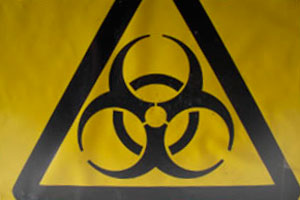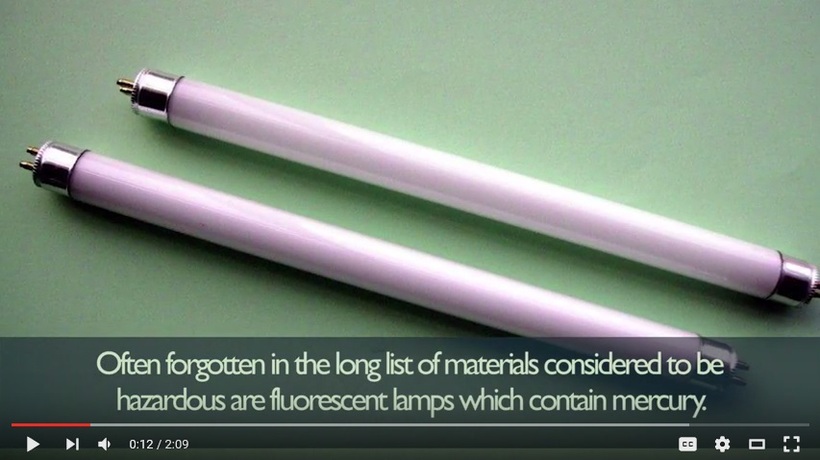
Hazardous Waste Warning
LessIsMore.org works best in modern browsers like Firefox, Safari, Chrome, or Internet Explorer 8. All are free to download and will greatly improve your internet experience. Wastes in this section are dangerous to you and the environment. Handle them carefully and dispose of them properly. Legally, households may not transport more than 15 gallons of wet or 125 pounds of dry hazardous materials. Read about the regulation.
Watch our new Fluorescent Lights Video!
Click here or below:
Handling Instructions for CFLs
Be careful not to break compact fluorescent lights (CFLs)! Each CFL contains a small amount of mercury, which can be dangerous if released into the open.
What if my bulb breaks?
Please take a look at our Broken Fluorescent Light Bulb Cleanup page for more information.
Really, these lights contain mercury?
Yes, mercury vapor is used to transport electrical currents through the light bulb. Even though the amount of mercury is relatively small, CFLs must still be disposed of as hazardous waste. Mercury is a toxic heavy metal that can cause severe damage to the brain, nervous system, kidneys, lungs, and other vital organs. Pregnant women, infants, and young children are especially at risk.
How should I store and transport my old CFLs?
Place your used CFLs in a sturdy container that has a lid; a box or bucket works well. Remember to keep the container in a safe spot, away from children and pets. When you're ready to head to a collection facility, put the container in your trunk or back seat, making sure to secure it so that it doesn't shake or tip over.
Read our most recent press release here.
Where to go
-
All of Santa Barbara County (1)
- Safety Kleen — 5310 Overpass Road
-
Carpinteria Area (1)
- City of Carpinteria ABOP Center — 5775 Carpinteria Ave
-
Santa Barbara Area (3)
- *Community Hazardous Waste Collection Center — University of California, Environmental Health and Safety Building, Building 565, Mesa Road
- *South Coast Recycling and Transfer Station — 4430 Calle Real
- MarBorg Industries’ Recycling /ABOP Center — 132 Nopalitos Way
-
Goleta & UCSB Area (4)
- *Community Hazardous Waste Collection Center — University of California, Environmental Health and Safety Building, Building 565, Mesa Road
- *South Coast Recycling & Transfer Station — 4430 Calle Real
- Home Depot — 6975 Marketplace Drive
- MarBorg Industries Recycling/ABOP Center — 20 David Love Place
-
Santa Ynez Valley (1)
- *Santa Ynez Valley Recycling and Transfer Station — 4004 Foxen Canyon Road
-
Lompoc Valley & VAFB (3)
- City of Lompoc Household Hazardous Waste Collection Facility — 1585 N. "V" St
- Home Depot — 1701 East Ocean Avenue
- LampRecycling.com — 2200 Oden Avenue, #100
-
Santa Maria Valley (2)
- City of Santa Maria Household Hazardous Waste Facility — 2065 East Main Street
- Home Depot — 2120 South Bradley Road
-
Outside Santa Barbara County (11)
- Asbury Environmental Services — 2100 North Alameda Street
- BGI — 527 North Rice Avenue
- C.J. Seto Support Services, LLC — 2300 Knoll Dr, Unit G
- Clean Harbors, Inc. — 880 W Verdulera St
- Earth911.com – Information Only — 3481 Plano Parkway
- Eco Lights Northwest Recycling Progam — 2200 6th Avenue South
- Industrial Waste Utilization — 5601 State Street
- LampRecycling.com — 2200 Ogden Avenue, #100
- Mercury Technologies of Minnesota, Inc. — P.O. Box 13
- Stericycle, Incorporated —
- Waste Management Incorporated, Think Green from Home —
Related Materials
- LED Lights
- Broken Fluorescent Light Clean-Up
- Product Stewardship
- Santa Ynez Valley Collection Event
- Glass Trash
- Recycling Resource Guide
- Mercury Containing Devices
- Fluorescent Light Tubes
- CFLs – Compact Fluorescent Lights
Related Articles
-
April 7th Hazardous Waste Collection Event
March 03, 2019 by Leslie Robinson - Hazardous Waste Recycling/Disposal -
Keep Your Waste in Check This Holiday Season
December 21, 2018 by Leslie Robinson - Reduce & Reuse -
Holiday Facility Closures
December 20, 2023 by Tori Kampmann - Hazardous Waste Recycling/Disposal -
“Less Is More” Guide Hot Off the Press
January 18, 2023 by Kaitlyn Haberlin - Recycle, Reduce & Reuse -
America Recycles Day November 15th
November 08, 2019 by Leslie Robinson - Recycle -
Latest Annual Report Available for County’s Hazardous Waste Collection Program
January 10, 2024 by Tori Kampmann - Hazardous Waste Recycling/Disposal -
Thomas Fire Clean-Up Tips & Guidelines
-
Thanksgiving Facility Closures
November 22, 2023 by Tori Kampmann - Hazardous Waste Recycling/Disposal -
RRWM’s Annual Waste Management Report Now Available
October 05, 2017 by Alan Nakashima - Recycle -
Easy Battery Recycling at Curbside
May 31, 2019 by Jody Rundle - Hazardous Waste Recycling/Disposal -
Safely Disposing of Fluorescent Lights
May 24, 2016 by Jody Rundle - Hazardous Waste Recycling/Disposal -
Battery Recycling Made Easy
November 30, 2015 by Jody Rundle - Hazardous Waste Recycling/Disposal -
Free Hazardous Waste Events October 5 & 6
September 30, 2019 by Leslie Robinson -
Reminder: Santa Ynez Valley Hazardous Waste Collection Event Postponed
March 23, 2020 by Leslie Robinson -
Hazardous Waste Collection Center Temporarily Closed – Updated 3/30/20
March 30, 2020 by Leslie Robinson - Hazardous Waste Recycling/Disposal -
Hazardous Waste Disposal Options in Santa Barbara County
June 04, 2021 by Tori Kampmann - Hazardous Waste Recycling/Disposal -
FREE Household Hazardous Waste Event!
March 31, 2024 by Kaitlyn Haberlin - Hazardous Waste Recycling/Disposal -
New Year, New Protocol!
February 02, 2022 by Tori Kampmann -
Hazardous Waste Center Closed for Easter Holiday
March 25, 2024 by Kaitlyn Haberlin
